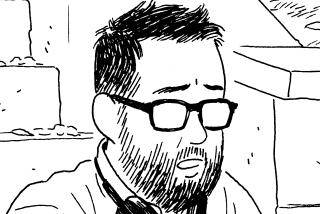VAN GOGH CENTENNIAL : VAN GOGH; His Life and His Art <i> By David Sweetman (Crown Publishers: $30; 368 pp., illustrated) </i>
Where many other writers have judged instability and inherited terrors as central to the development of Vincent van Goghâs genius, David Sweetman, author of the biographical âVincent van Gogh: His Life and His Art,â protests. âNo matter what (Van Gogh) suffered,â he writes, âdespair was never the dominant element in his thoughts and his suicide does not alter that.â
In a few instances, the author even seems to tip the balance of evidence, just to avoid despair-mongering (as when he reports Gauguinâs largely discredited version of the sliced-ear incident, or suggests that Van Goghâs point-blank shot to the left side of his chest may have been a âbungled gestureâ not intentionally suicidal). The attempt is unconvincing. Overall, however, Sweetmanâs feet-on-the-ground, custodial approach to his subject offers more of real value than it withholds in controversy.
Sweetman, a British art historian-BBC producer, is a sensitive, wryly humorous writer who plainly has devoted much thoughtful research to social environment and to the curious amalgam of accident, ambition and hard labor that transformed a hapless, âweedy little man . . . hissing through his teethâ (as described by a fellow art student) into a master of grace.
The book draws us confidently into a never-simple web of personal and social dynamics and historical detail in a way Van Goghâs art work (which eschews realistic detail) and his letters (which often describe states of mind not borne out by the work) cannot. For example, we learn at one point that Charles Verlat, the imperious, disapproving director of an art academy Van Gogh attended, happened to be âa master of . . . dead classicismâ who nonetheless âdisgraced himself by painting 13 spokes on a chariot wheel,â and whose hobby was making little pictures âin which monkeys played human roles.â
The talented and radical Van Gogh, too, painted for complicated reasons. The famous portrait of his pristine, golden bedroom in Arles was, for example, âa fantasyâ of domesticity, made in preparation for Gauguinâs arrival there--a picture of comfort to ward off the ârising tide of debrisâ in his real rooms and the loneliness he really endured amid the âhermetic societyâ of Provence.
Protective yet realistic, armed against mythologizers while attending carefully to the oblique meanings of the artistâs habits, associates and whereabouts, this biographer is the voice of the fond, sensible and intimate older brother that the living Vincent van Gogh lacked.
More to Read
The biggest entertainment stories
Get our big stories about Hollywood, film, television, music, arts, culture and more right in your inbox as soon as they publish.
You may occasionally receive promotional content from the Los Angeles Times.










